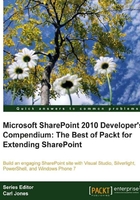
What this book covers
Chapter 1, Understanding SharePoint Development Choices, provides some high level guidance over the different customization options that are available, tools that can be used to create different solutions, as well as some additional considerations when choosing a development path.
Chapter 2, Building an Engaging Community Site, takes the reader through the configuration and development of a community site that is meant to enhance collaboration and provide information sharing capabilities.
Chapter 3, PowerShell scripting methods and creating custom PowerShell commands, takes you further with PowerShell to create your own PowerShell commands (CMDLETs) and snap-ins and share them with your team.
Chapter 4, Integrating Silverlight 4 with SharePoint 2010, briefs you about the integration of Silverlight 4 applications with SharePoint 2010 sites and solutions. In this chapter, you will learn to prepare a development environment and look at the tools to work with Silverlight 4 RIAs. You will also configure the SharePoint 2010 server and add Silverlight Web Parts to a new page. Finally, you will create your first Silverlight RIA and then make it available in a SharePoint site.
Chapter 5, Interacting with Rich Media and Animations, will help you access asset libraries in a Silverlight RIA rendered in a SharePoint Visual Web Part. In this chapter, you will learn to take advantage of Silverlight 4 rich media features to add effects and interactive animations to images and videos.
Chapter 6, List Definitions and Content Types, will help you discover the world of content types. You will use object models to create content types, add new columns, document templates, and workflows to content types using Visual Studio 2010. This chapter also guides you through the process of creating external content types that are linked to an external data source such as the SQL Server database. At the end of the chapter, you will also learn how to create list definitions using Visual Studio.
Chapter 7, Workflows, will teach you about sequential workflows, site workflows and deploying custom initiation forms with workflows using ASPX pages and InfoPath forms. You will also learn to create custom InfoPath task forms with the workflows.
Chapter 8, Introduction to Programming Windows Phone 7 with the SharePoint Client Services, dives into building Windows Phone 7 applications that utilize SharePoint data. After a brief discussion of security in SharePoint, the chapter provides an example of building a simple RSS reader. The simple RSS reader gets data from an anonymous RSS feed from a SharePoint list, and discusses many of the basics of building a Windows Phone 7 application.
Chapter 9, Building SharePoint Pages for Windows Phone 7, begins with an examination of the difference between data stored as lists and libraries. Then it describes adding columns to a list and customizing the list item output. The chapter ends with an example of replacing the mobile home page.
Chapter 10, Building a Windows Phone 7 Dashboard Application with SharePoint Data, begins with a discussion of security in SharePoint and the example in this chapter utilizes forms based authentication in SharePoint. After a brief discussion of the tools available for building SharePoint applications on the desktop, the focus turns to building out the dashboard application for Windows Phone 7.